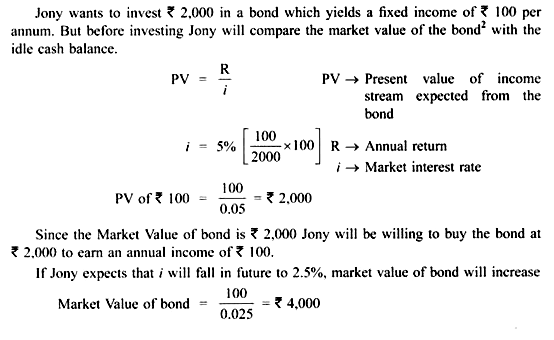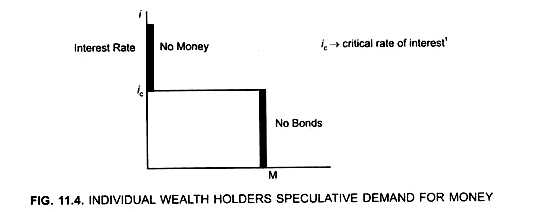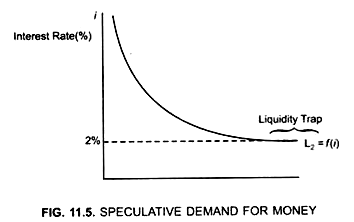The concept of liquidity trap was given by the English Economist, John Maynard Keynes. He views that an individuals’ demand for money balances for speculative purposes depends on the rate of interest.
People desire to buy long-term bonds when their prices are low and sell them when their prices are high.
The yield from the bonds is usually termed as the rate of interest. Bond prices and the interest rates are inversely related.
Keynes viewed that if the interest rate was expected to rise in the future, people would hold idle cash balance instead of holding a bond. This is because when he will buy a bond at a lower price he will make a capital gain as he will earn a high rate of return on the bond. A rise in the market rate of interest will lead to an increase in the market value of the bond. For example,
Since the market value of bond is expected to increase in future, Jony will buy the bond at Rs. 2,000 and sell it in future at Rs. 4,000.
Capital gain will be = Rs. 2,000.
Thus, when people expect interest rate to fall in the future, preference for bonds will increase. Therefore, speculative demand for money will increase.
If: i < ic – Anticipated capital loss will be very large. Wealth holders will hold money only.
ADVERTISEMENTS:
i > ic – Wealth holders will hold bonds and the speculative demand for money will be zero.
i = ic – Wealth holders will be indifferent between money and bonds.
At i → 2%
ADVERTISEMENTS:
Speculative demand for money becomes infinitely large. Interest elasticity of demand for speculative balances will be infinite and the curve will become parallel to X-axis. This is the Liquidity Trap Region (Fig. 11.5). At this interest rate the wealth holders will prefer to hold their entire assets in form of money because at this interest rate the opportunity cost of holding assets in form of
money is zero.
People begin to believe that the interest rate will not fall further, as it has already reached its critical minimum level. Rather they expect that the interest rate will increase and the bond prices will decrease causing a capital loss. They will start selling their bonds and accumulate cash balance.
All people will prefer idle cash balance to bond holding. Even if the monetary authorities decrease the interest rate by increasing the money supply, the entire increase in money supply will be trapped as extra idle cash balance. This is the liquidity trap as called by Keynes.


